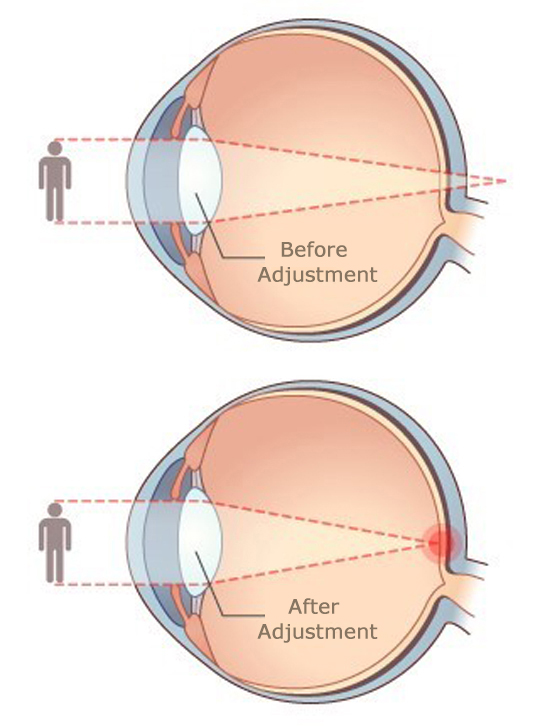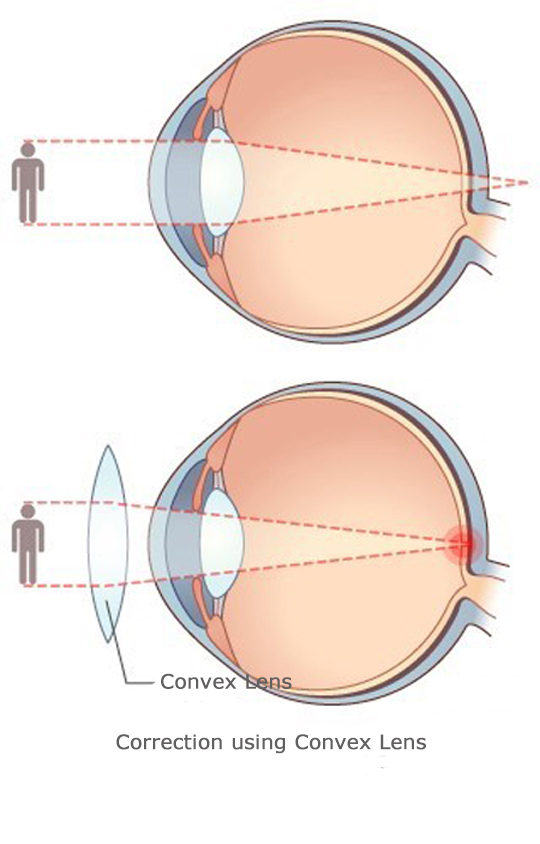Hyperopia
Often known as far-sightedness, the condition refers to hindrance in vision due to images being focussed behind the retina, allowing closer objects to appearblurry while farther objects clear.

Definition
The condition in which incoming parallellight ray through eye deflects and forms an image at a converging spot behind the retina. Caused by shorter spherical diameter of the eyeball compared to the angle of deflection that depends on thickness of the cornea and crystallinelens, the image of the objects of sight forms behind the retina, and makes it harder for the person to perceive nearby objects while objects at a longer distance appear clear.
Causes
The condition can be classified by its causes:
Axial Hyperopia, caused by short spherical distance of the eyeball and Refractive Hyperopia, caused by weak deflective power of the cornea and crystalline lens. Although the condition tends to begenetically inherited, the exact causes of hyperopia itself is unknown.
Symptoms
People with Minor Hyperopia, with enough accommodative force(the power through which the crystalline lens expands to provide adequate deflective power to focuss the image of the objects onto the retina), do not display protruding observable symptoms and sometimes do not experience any hindrance in vision. However, when the conditions become severe,people often experience decreased perceptive sight and amblyopia.
When viewing objects far away, the accommodativ eforce becomes stronger to enhance the refractive power of the crystalline lens to compensate for hyperopia, and when viewing objects at a close distance, the adjustment becomes even stronger. Such eye fatigue due to the adjustments work as a main cause of various types of visual acuity deterioration and accommodated symptoms, including the eye pain and headaches, congestion of eyes, fever, feeling of dryness, frequent blinks, teary eyes. When the excessive adjustment of the crystalline lens and the conditions become severe symptoms such as strabismus(the inclination of eyes to inward positions caused by hindrance in vision of two aligned eyes) or permanent cross-eye(the in clination of eyes to inward positions even when there is no hindrance in vision of two aligned eye sights).
In the case for young children with hyperopia, who still display high accommodation power in general, there is atendency to try to enlarge the retinal image by manual adjustments such asbringing the book closer to the eyes. However, with age, the loss o faccommodative force causes presbyopia to occur sooner compared to stereoscopiceye(a state in which parallel rays entering the eye in an unregulated state are refracted and focused on the retina) or myopia(state in which parallel raysentering the eye in an unregulated state are refracted and focused to an image that forms in front of the retina).

Diagnosis
Diagnosis of hyperopia is not just determined by its symptoms. Rather, close examination of visionary acuity and anterior ocular segment of the eye, and retinal examination must accompany in order to find the cause for the decreased vision.
Examination
The method of examining refraction includes a retina inspection directly performed by a physician and an automatic refraction inspection utilizing an automated instrument.
By implementing repeated refraction tests without utilizing adjustment paralyzant before the actual test, the patient can undergo adjustment paralyzant refraction test with an
adequately relaxed state of the crystalline lens. In many cases(young or cross-eyed patients, patients displaying even severe adjustment conditions, patients with clouded eyes
that cannot be subject to retinal examinations) the paralyzant refraction test must be implemented only after verifying that the actual results of refractive abnormality test and
the extent of patient’s perception of refractive abnormality share similar degree.
Remedy
Even if a patient has a mild hyperopia, he/she does not necessarily has to go through correction as long as his/her vision is good and without eye fatigue symptoms caused by
adjustment. However, if there are symptoms such as visual acuity deterioration due to hyperopia, amblyopia, symptoms of eye fatigue due to adjustment, the extent of refractive
error obtained by the refraction examination can be corrected by using a convex lens. However, hyperopia accompanied by cross-eye symptoms must always be examined by
adjustment paralyzing refraction test to correct hyperopia. For severe cross eye symptoms that cannot be remedied even with eyeglasses for correcting hyperopia, surgical
treatment may be necessary. We can also treat hyperopia by using hyperopic corrective contact lens or hyperopic corrective refractive surgery. In case, of patients who have
undergone surgery for cataract, there also exists on option of adjusting refractive rates of artificial crystalline lens so that patients can be return back to normal conditions.

Remedy Progress/Complications
Generally, when a child is hyperopic, the spherical diameter of the eyeball becomes longer, and the length of symptoms gradually
decreases. However, as these children who have undergone treatment grow up, anomalies such as returning to normal eyes or
even nearsightedness may occur. For adults, it is rare to find worsened case after treatment, but presbyopia, in which
accommodation power decreases and closer things become invisible, can occur early.
Everyday Guide
For many children’s cases, there is a tendency of not letting youngkids use glasses when they can see distant place better, and also when they areaccustomed to adjusting their vision for near objects. However, such ignorancemay act as a cause for amblyopia or strabismus due to hyperopia. Wearingglasses is necessary for these patients.